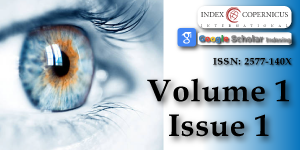Detection of Ganglion Cell Loss in Preperimetric Glaucoma by Fourier-Domain Optical Coherence Tomography
Main Article Content
Abstract
Background: Glaucoma is a multi-factorial optic neuropathy characterized by a loss of retinal ganglion cells with subsequent loss of the retinal nerve fibers ultimately resulting in visual impairment. The macula region has a high density of retinal ganglion cells thereby being a likely region to detect early cell loss .Since glaucoma affects mainly the inner layers of the retina, Ganglion Cell Complex (GCC) mapping can help to detect glaucomatous damage early as compared to the total retinal thickness.
Purpose: To map GCC thickness and average Macular Retinal (MR) thickness with high-speed Fourier-Domain Optical Coherence Tomography (FD-OCT) and correlate it with the Retinal Nerve fiber layer (RNFL) thickness in preperimetric glaucoma.
Design: Observational cross-sectional study.
Methods: Forty four eyes diagnosed as preperimetric glaucoma were studied. GCC, MR thickness and RNFL thickness was mapped using the RTVue FD-OCT system. The GCC thickness map, the deviation map and the significance map were obtained in all cases. Average GCC thickness and MR thickness were correlated with the RNFL thickness.
Results: Average GCC of patients was 85.99±6.9 µm. There was GCC loss in 35 (87.5%) eyes which correlated well with areas of RNFL loss (r=0.408, p<0.001). Nine (22.5%) eyes were seen to have decreased MR thickness. GCC loss correlated well with the loss of average RNFL thickness and MR thickness. Further GCC loss was also seen in 23 (74.19 %) eyes with a normal MR thickness.
Conclusion: GCC analysis may prove to be a robust diagnostic parameter and is complementary to RNFL analysis in preperimetric glaucoma.
Article Details
Copyright (c) 2017 Dubey S, et al.

This work is licensed under a Creative Commons Attribution 4.0 International License.
Osborne NN, Chidlow G, Nash MS, Wood JP. The potential of neuroprotection in glaucoma treatment. Curr Opin Ophthalmol. 1999; 10: 82-92. Ref.: https://goo.gl/RPEigL
Neufeld AH. New conceptual approaches for pharmacological neuroprotection in glaucomatous neuronal degeneration. J Glaucoma. 1998; 7: 434-438. Ref.: https://goo.gl/Ac457w
Schuman JS, Hee MR, Puliafito CA, Wong C, Pedut-Kloizman T, et al. Quantification of nerve fiber layer thickness in normal and glaucomatous eyes using optical coherence tomography. Arch Ophthalmol. 1995; 113: 586-596. Ref.: https://goo.gl/rBeZTV
Mistlberger A, Liebmann JM, Greenfield DS, Pons ME, Hoh ST, et al. Heidelberg retinal tomography and optical coherence tomography in normal, ocular hypertensive and glaucomatous eyes. Ophthalmology. 1999; 106: 2027-2032. Ref.: https://goo.gl/fsUCPP
Zeimer R, Asrani S, Zou S, Quigley H, Jampel H. Quantitative detection of glaucomatous damage at the posterior pole by retinal thickness mapping: a pilot study. Ophthalmology. 1998; 105: 224-231. Ref.: https://goo.gl/KqHKJ8
Huang D, Swanson EA, Lin CP, Schuman JS, Stinson WG, et al. Optical Coherence Tomography. Science. 1991; 254: 1178-1181. Ref.: https://goo.gl/WazgmZ
Bagga H, Greenfield DS, Knighton RW. Macular symmetry testing for glaucoma detection. J Glaucoma. 2005; 14: 358-363. Ref.: https://goo.gl/JVhWb5
Sommer A, Miller NR, Pollack I, Maumenee AE, George T. The nerve fiber layer in the diagnosis of glaucoma. Arch Ophthalmol. 1977; 95: 2149-2156. Ref.: https://goo.gl/7Pj2T3
Guedes V, Schuman JS, Hertzmark E, Wollstein G, Correnti A, et al. Optical coherence tomography: measurement of macular and nerve fiber layer thickness in normal and glaucomatous human eyes. Ophthalmology. 2003; 110: 177-189. Ref.: https://goo.gl/9Cx3Py
Frishman LJ, Shen FF, Du L, Robson JG, Harwerth RS, et al. The scotopic electroretinogram of macaque after retinal ganglion cell loss from experimental glaucoma. Invest Ophthalmol Vis Sci. 1996; 37: 125-141. Ref.: https://goo.gl/Ae6ndt
Glovinsky Y, Quigley HA, Pease ME. Foveal ganglion cell loss is size dependent in experimental glaucoma. Invest Ophthalmol Vis Sci. 1993; 34: 395-400. Ref.: https://goo.gl/2MTq4x
Wollstein G, Schuman JS, Price LL, Aydin A, Beaton SA, et al. Optical coherence tomography (OCT) macular and peripapillary retinal nerve fiber layer measurements and automated visual fields. Am J Ophthalmol. 2004; 138: 218-225. Ref.: https://goo.gl/QqoLrQ
Medeiros FA, Zangwill LM, Bowd C, Vessani RM, Susanna R Jr, et al. Evaluation of retinal nerve fiber layer, optic nerve head and macular thickness measurements for glaucoma detection using optical coherence tomography. Am J Ophthalmol. 2005; 139: 44-55. Ref.: https://goo.gl/XAKuAV
Ishikawa H, Stein DM, Wollstein G, Beaton S, Fujimoto JG, et al. Macular segmentation with optical coherence tomography. Invest Ophthalmol Vis Sci. 2005; 46: 2012-17. Ref.: https://goo.gl/o6A638
Leung CK, Chan WM, Yung WH, Ng AC, Woo J, et al. Comparison of macular and peripapillary measurements for the detection of glaucoma: an optical coherence tomography study. Ophthalmology. 2005; 112: 391-400. Ref.: https://goo.gl/4xt37g
Greenfield DS, Bagga H, Knighton RW. Macular thickness changes in glaucomatous optic neuropathy detected using optical coherence tomography. Arch Ophthalmol. 2003; 121: 41-46. Ref.: https://goo.gl/wRBvRH
Tan O, Chopra V, Lu AT, Schuman JS, Ishikawa H, et al. Detection of Macular Ganglion Cell loss in glaucoma by Fourier-Domain Optical Coherence Tomography. Ophthalmology. 2009; 116: 2305-2314. Ref.: https://goo.gl/o5Khsf
Takagi ST, Nose A, Kita Y, Tomita G. Inner Retinal Layer Measurements in Macular Region With Fourier Domain Optical Coherence Tomography in Glaucomatous Eyes With Hemifield Defects. Invest Ophthalmol Vis Sci. 2008; 49. Ref.: https://goo.gl/Dqqe8k
Mori S, Hangai M, Nakanishi H, Kotera Y, Inoue R, et al. Macular Inner and Total Retinal Volume Measurement by Spectral Domain Optical Coherence Tomography for Glaucoma Diagnosis. Invest Ophthalmol Vis Sci. 2008; 49. Ref.: https://goo.gl/vcmw4H

